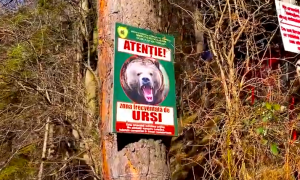
The Bear Necessities
The LiBEARty Bear Sanctuary, Romania
A blog post by Lady Felicity
When Greg suggested we go to Romania to film our travel adventure video ‘Romania: Seeking Dracula’s Castle (which you can watch from the links at the end of this video), I was instantly excited. If you have read my previous blog post you will already know of my interest not only in the fictional Dracula, but particularly in the man behind the myth, Vlad the Impaler.
Research into the various locations in Romania with a significant link to either Dracula began immediately. I also like to make sure we see the best of whatever country we visit, however, even if it doesn’t necessarily tie into the documentary’s main focus. We discovered some interesting dinosaur, fossil and geology related places which we touch on in the video, but one of the big things I wished to include was the country’s bear population.
Romania is estimated to have some 6,000 brown (aka grizzly) bears living in its forested mountains. Last year (2019) there was an increase in bear attacks on people, with some proving to be fatal. Many of the locals living in small villages near the bear’s habitat in the mountains wished to cull the bears’ numbers while conservationists push for the bears to be protected. Trying to balance this, it was finally decided that a license would be given to hunters allowing a set number of bears to be killed each year. Tourists pay a lot of money to go out with these licensed hunters to shoot the bears.
The idea was to kill the bears coming into contact with people, but these are usually the small, undernourished, starving bears that seek food scraps from bins and campsites. Hardly a ‘decent trophy’.
The hunters go into the mountains and kill the larger grizzly bears that likely never leave their own habitats. This result satisfies neither the villagers living in fear of the bears, nor the conservationists trying to save them. I think that most people could see this dilemma from both sides. My love of animals means I would never wish for any animal to be harmed, but I can easily understand not wanting to be lunch for a hungry bear!
When I read a bit more about some of the bear attacks I discovered that one of the key places we would be visiting (Poenari Fortress) was a hot spot for bears coming into conflict with humans. So much so that a lot of our research indicated that the access to Poenari Fortress, with its 1,480 stairs through forest leading up the mountain, (if a bear doesn’t kill you the climb just might!) is regularly closed.
Since a mother bear with her two cubs recently attacked some tourists, it had been closed while they tried to figure out a way to prevent this being a problem in the future and reportedly would not open till the issue was resolved. We found a few conflicting dates as to when the access would reopen and so in the end Greg emailed Visit Romania, who indicated it had just reopened.
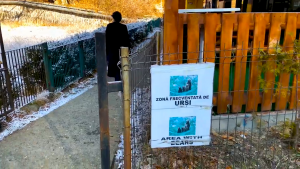
During my research I discovered that in the summer months it is possible to go into the forests with the conservationists. As well as visiting schools to raise awareness and understanding regarding the bears with the locals and the younger generation, the conservationists try to encourage this positive attitude towards the bears with the tourists too. I loved the idea and was disappointed to discover we would be in Romania during the bears’ hibernation period, so no tours would be running. On the one hand I was relieved that it was therefore unlikely we would have a potentially dangerous encounter with a bear during our visit, but it also meant it would be unlikely we would be able to include the bears in our documentary.
As our visit to Romania neared, we discovered one holiday maker had encountered a bear near Poenari Fortress about two weeks before we were due to visit. It turns out the weather this winter is warmer than usual and heating up each year. This plays havoc with the bears’ hibernation. Some still sleep while many have a shortened hibernation or don’t seem to bother at all.
Excited and rather nervous, I longed to see a bear in the wild but preferably from a safe distance! I even went so far as to drag Greg to the area along the river beneath Poenari where bears are often sighted in an attempt to encounter one. Though we did this twice, we were unsuccessful. Seeing my disappointment, Greg went for plan B.

The LiBEARty Bear sanctuary.
Ordinarily I am dubious about so called ‘sanctuaries’. So many of them sound so good, rescuing, rehabilitating and releasing animals wherever possible. They sound perfect and some of them truly are. Many, however, cross a line. Once they start breeding non-endangered animals rather than rescuing injured or ill-treated ones, they cross from sanctuary towards zoo in my mind. Some have ample land with lots of space for the animals while others have tiny enclosures. There are different levels of sanctuary but no animal should be forced to spend its life in a small cage.
We spent the evening in our hotel room researching the sanctuary, making sure we could find nothing to suggest it went against our beliefs and morals regarding animal welfare. Once satisfied we booked a tour with them. This process in itself was an indicator as to what the bear sanctuary is like. You can only enter the sanctuary on a guided, one-hour tour, which has limited numbers per tour as well as running only at set hours. They only run a few tours a day (in English and Romanian) and children under 5 years old are not permitted. Straight away this felt right, focusing more on the animals in their care rather than on having as many tourists, and therefore profits, as possible.
The LiBEARty bear sanctuary is the largest animal welfare project in Europe. In 1998 a Romanian woman, Christina Lapis, saw 3 bears in tiny cages outside Romanian restaurants. Later she discovered more bears in similar conditions such as outside petrol stations. The bears in each place were kept to attract customers and they all lived in terrible conditions.
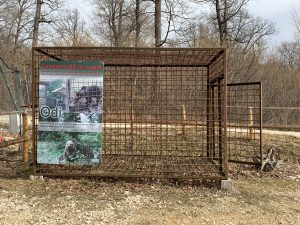
Her aim was to stop this cruel and illegal exploitation of these incredible, native animals. Reporting these places with their captive bears to the police did no good- the bears could be confiscated but having lived their life since infancy in a cage they could not be returned to the wild. For one thing they would not survive, and for another they were too used to people and would either seek people out for food or because they were traumatized and therefore now aggressive towards people. No safe place existed for them – if confiscated they would be shot.
Christina Lapis created an organization- Milioane de Prieteni (Millions of Friends), which is based in Brasov, Romania. In 2005 the Millions of Friends Association signed a public-private partnership with the Town Hall of Zarnesti, through which they received a 49 year concession for the necessary land to build the ‘LiBEARty’ sanctuary.
WAP (World Animal Protection) joined these efforts in the ‘Save the Captive Bear’ project. It is now the largest project in Europe for the rescue, care and welfare of the brown bear. Millions of Friends also created a school education program teaching about animal welfare.
The sanctuary has 69 hectares of oak forest containing trees for the bears to climb and swimming pools to cool off and splash in, as well as appropriate food according to their natural diet and medical needs.
The tour started with a video giving the history and a brief overview of the sanctuary. The video only lasted a few minutes but those minutes had me in tears.
The sanctuary doesn’t want healthy, wild bears. That isn’t the idea at all. Those bears should be in the wild where they belong. No, this sanctuary is for the bears that have been captured and traumatized by people. The introduction video showed some of the bears in the cages where they had spent their whole lives up till the point the sanctuary saved them. One bear was kept in an elevated cage so that the bears’ waste would drop to the ground below and be easier for the ‘owner’ to keep clean. This meant that for years the bear had nothing but large metal grids on which to stand, sit and lay upon. The bear lived for years in agony and now it has comfort in the sanctuary but the damage is done, both to her feet and her mind. Seeing people distresses her and she can barely walk. We do not see this bear in the sanctuary- any bear that finds it too traumatic to see people is protected from visitors. If we wish to see these bears there is a link on their website which takes you to a live camera feed. They are looked after but are kept as wild and peaceful as possible.
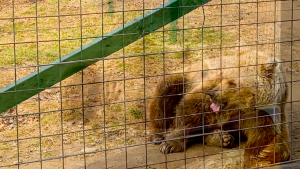
As we walked around the sanctuary with our tour guide (there were only about eight of us on the tour) she went into details about the bears we saw, their past, their rehabilitation and personalities now. We learnt a bit more about the sanctuary, how it is run and how they deal with various problems with the traumatized bears. Her love and sympathy for the animals was clear and she was happy to answer my many questions.
Some of the bears come from zoos. Since Romania joined the EU many zoos were either closed or had to raise their standards to meet with the EU animal welfare regulations. One example of this will always be with me. One bear aged about 15 had spent her life in a tiny cage in one of these zoos. When the zoo enlarged the enclosure to meet with the new regulations they got two more bears.
The original bear was picked on by these other two and was too afraid to leave her cage and move into the new enclosure. Someone visiting the zoo reported it to the LiBEARty Sanctuary and they rescued not only the bear but some wolves who were also kept in substandard conditions in the zoo. EU regulations may have improved things but they are still, in my opinion, still so far away from good or right. When we saw this bear we had to keep our distance so as not to agitate her further. She is now in a large enclosure though she doesn’t seem to realize it. She spends her days pacing back and forth along one small section of fence and each time she reaches the corner she bashes her head into the wall. Normally the enclosures have a line of electric fence to deter the bears from climbing out but they couldn’t do this with her. She has smooth metal sheets at the top of the enclosure to stop her scaling them. Like most of the rescue bears, she is smaller than she should be. Being kept in small cages and fed largely human scraps rather than their proper diet, they have stunted growth amongst other issues. Watching this beautiful girl pace in stress and agitation, knowing it was a zoo that had done this to her, caused irreparable mental damage… it still makes me tearful now, just the memory of her.
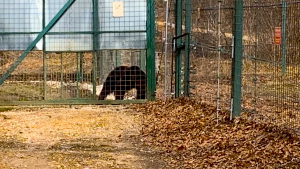
Some of the bears we passed seemed happy, content with their lot in life, but the fact they seek us out and walk along beside us as we tour the sanctuary indicates the damage. Bears do not seek people out if they are healthy and happy.
It was at this point I felt a little bad for my wanting to see one in the wild when visiting Poenari Fortress. We learned from our guide of a location not a million miles away where wild bears are almost always present. Tourists park there and feed the wild bears. This encourages more bears and it encourages them to approach people and their cars. Some bears are hit by the cars as a result and some people get overconfident.
It seemed crazy to me but one lady was apparently so confident after feeding this bear from her car, she actually got out and turned around to take a selfie picture with the bear! She got more than she bargained for when the bear gave her more than a hug! Who would be crazy enough to turn their back on a grisly bear stood an arm’s length away!? This woman, apparently, and she is not the only one trying to get too close to these large, wild animals. My wish was to see bears in the wild but when people start to interfere and tempt them closer to roads and villages, no good can ever come from that.
A line from Jurassic Park which I love, ‘These creatures require our absence to survive, not our help”. I too wanted to see them but not when it changes their natural behavior and endangers them as well as people. A tourist can leave, what about the locals that live nearby and now have bears seeking out human scraps once tourist season is over? I believe that these people meant no harm, it is their ignorance that does harm. Visiting the bear sanctuary, hearing the stories, seeing the damaged bears, the ignorance is not an excuse. People need to see, learn and respect the life around them.
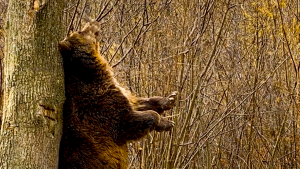
From bears that pirouette whenever they see a person as this was how they earned their food, to bears that think they are human and want to be close to us, to bears that can’t stand the sight of humans, the sanctuary has it all. They have so far rescued over 125 bears from what was an abusive nightmare of a life before finding as much comfort and normality as the sanctuary can provide. The mission is expanding though. A true animal lover struggles to draw the line at one species and now the park is also home to some wolves and deer that needed the help too.
On a separate site to the LiBEARty sanctuary they have created ‘Victory’, a dog shelter dedicated to the care of stray dogs, as well as offering help to dog owners in the community. The shelter has a veterinary clinic where they neuter people’s dogs for free. They rescue, treat, house and re-home stray dogs and help owners with their pets too. Driving around Romania, so many stray dogs are in need of help but places like ‘Victory’ are now working to improve this. Slowly, people are learning.
Education is such an important step and those steps are slowly but surely happening. One story from the bear sanctuary had such hope. A hunter visited the sanctuary and has since stopped hunting. He explained he had never seen the bears in this light before. They were a way to make money, nothing more. After seeing them at the sanctuary, he couldn’t kill them anymore. It changed his life.
The bear sanctuary is a true sanctuary. It isn’t about money – they borrow rather than own the land. The animals are neutered not bred and if they ever run out of bears needing help they would happily close, mission accomplished. If a billionaire gave them enough money to mean the need for tourist donations was gone, they would likely close their doors so the bears never had to see a tourist again. As it is, the sanctuary does the very best for the bears that it possibly can.
If you ever plan to visit Romania (when the current world crisis has passed and we are all able to travel again!) I highly recommend it but most of all I hope people will visit the sanctuary, support their cause, donate, ‘adopt’ a bear, watch their live camera feed online… even if you don’t visit Romania much of this is possible from the comfort of your own home so long as you have an internet connection and a warm heart.
I know that with the way things currently stand in the world and the crisis we are going through this year, a lot of people are comparing themselves to caged animals. They have no idea. Not really. But we do all miss freedom and safety. In that we are all alike.
Thank you for reading, take care and stay safe.
Felicity
Find out more about:
P.S.
If you enjoyed this blog post, please leave a comment and say ‘hello’!
For information on all of our projects, visit: www.gregandfelicityadventures.com
Follow us on Instagram at: https://www.instagram.com/gregandfelicity
Like us on Facebook at: https://www.facebook.com/GregandFelicityAdventures
There are various places you can watch our documentaries and series!
Seeking Cetaceans In Scotland: A two-part documentary about the work of the Cetacean Research and Rescue Unit as they work to help whales, dolphins and porpoises in the Moray Firth in Scotland:
Free in the USA on Tubi TV at:
https://tubitv.com/movies/678018/seeking-cetaceans-in-scotland
Free Worldwide on PlexTV at:
https://watch.plex.tv/movie/seeking-cetaceans-in-scotland
With a library card on the Hoopla service where applicable:
https://www.hoopladigital.com/title/15313766
Free in the USA on Xumo at:
https://www.xumo.tv/channel/99991731/free-documentaries?v=XM00ILOFXCKLUC&p=74071
Buy it without ads Amazon’s Prime Video at:
UK: https://www.amazon.co.uk/dp/B09RVWVFCV
USA: https://www.amazon.com/dp/B09RVWJGY1
(Greg and Felicity are donating half of our streaming income on this documentary to support the CRRU).
Available to buy on DVD (with £5 from each donated to the charity): https://ko-fi.com/s/73e469d114
ROMANIA: SEEKING DRACULA’S CASTLE: Our travel documentary looking into the history, legend and castles connected to Vlad Dracula III, sometimes known as Vlad the Impaler, and a journey around Romania:
Free Worldwide on Plex: https://watch.plex.tv/movie/romania-seeking-draculas-castle
Free (USA) on Tubi: https://tubitv.com/movies/579192/romania-seeking-dracula-s-castle
Prime Video (From £1.99, no Ads) (UK): https://www.amazon.co.uk//dp/B08RDPZP14
Prime Video (From $1.99, no Ads) (USA): https://www.amazon.com/dp/B08RDJR4F2
TURKEY: FAIRY CHIMNEYS AND UNDERGROUND CITIES: A travel documentary across Turkey, from the Fairy Chimneys and Underground Cities of Cappadocia to the ancient Greek ruins of Ephesus and Hierapolis:
Prime Video UK (From £2.49, no Ads): https://www.amazon.co.uk/Turkey-Fairy-Chimneys-Underground-Cities/dp/B09KKSZLRW
Prime Video USA (From $1.99, no Ads): https://www.amazon.com/Turkey-Fairy-Chimneys-Underground-Cities/dp/B09KK6VDJB
Free Worldwide on Plex: https://watch.plex.tv/movie/turkey-fairy-chimneys-and-underground-cities
Free (USA) on Tubi: https://tubitv.com/movies/579225/turkey-fairy-chimneys-and-underground-cities
Greg Chapman’s Magic Show: An eight-part series of magic and entertainment with Greg:
Free in the USA on Tubi at: https://tubitv.com/series/300008713/greg-chapman-s-magic-show
Free worldwide on Plex: https://watch.plex.tv/show/greg-chapmans-magic-show/season/1
Available to buy on DVD: https://ko-fi.com/s/7c1bc10a08
Mexico: Mayan Mystery and Marine Majesty: Filmed on our honeymoon in Mexico in 2019, our first travel documentary took us through the ancient sites of Teotihuacan, Uxmal, El Tajin, Palenque, Chichen Itza and Calakmul, and then on to see the whales of Magdalena Bay, whale sharks of La Paz, and more.
Watch free on YouTube: https://youtu.be/yfMpD868MHU
The Isle of Man: Railways, Castles and Seals: Our second travel documentary took us to the Isle of Man!
Watch free on YouTube: https://youtu.be/uCpUa6XEkbg